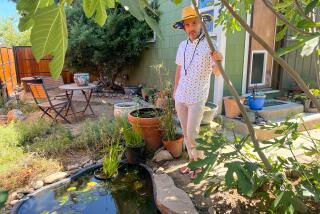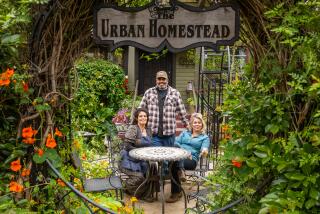Novice’s guide to an urban homestead
FARMING is inherently an optimistic act, a belief that you and your hands can make something happen, even if you couldn’t last year. That’s a good thing, because nurturing your crops to a fruitful harvest can take some trial and error as you find the right mix of soil, sun and weather exposure. Plants sensitive to cold, for instance, may grow better close to the house, where it may be warmer than in the rest of the yard.
Jules Dervaes suggests starting your micro-farm with just a few plants, hardy ones that will do well even for rookie green thumbs. Start with some herbs, such as basil, and tomatoes. And even the horticulturally challenged can triumph with squash.
You’ll want to spend serious time upfront getting the soil right. “If you don’t have healthy soil, you don’t have healthy plants,” he says. Think in terms of feeding the soil as much as the plant, with a regimen that includes mulching and compost.
As you add more plants, you have to be imaginative in maximizing space. Dervaes and his three adult children use trellises along the walls and down the center of the backyard for snow peas and flowers. In one optimizing technique traditionally used by Native American gardeners, they combine several plants in a “three sisters” bed -- black Mexican/Aztec corn, cornfield beans and winter squashes with a cover crop of mustard. The family has a portable corridor of crops grown in pots they can rotate depending on the season.
Because of space limitations, home farmers need to pick their plants carefully, going for harder-to-find items that can fetch a premium price, Dervaes says. That means you need quality customers who will choose taste over price.
His family started with flowers, selling them to local stores. Building on that success, they hit the streets to see whether their salad greens could find a market. They discovered that getting their products taste-tested by the chef got them on the table. It’s possible to break through to the restaurant market, Dervaes says, because owners are always looking for freshness.
Customers have to be able to adapt to your micro-supplies. The Dervaeses have had to limit sales to customers who can adjust to their crop availabilities and quantities.
Dervaes suggests that would-be urban homesteaders first try in a small way at a community garden or by selling to churches or schools. If you want some up-close advice, he holds evening classes in the warm months in everything from gardening to making your own biodiesel.
If at first you don’t succeed, keep going back to the drawing board, he says. “There’s failing, but when you climb to the top of the mountain, you feel pretty good.”
-- Joe Robinson






